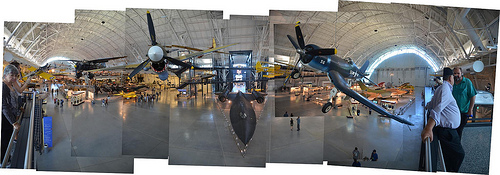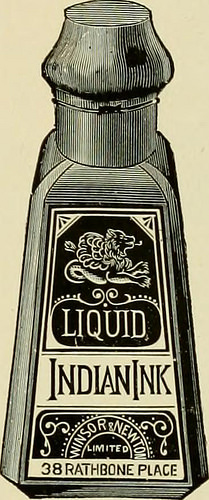A handful of good chinese trading companies images I identified:
Steven F. Udvar-Hazy Center: Photomontage of major entrance view, which includes P-40 Warhawk & F-4 Corsair up front, SR-71 Background beneath in the close to distance, and the Space Shuttle Enterprise beyond

Image by Chris Devers
Blogged on ☛ HoloChromaCinePhotoRamaScope‽ as: Bye bye, Miss American Pie.
• • • • •
Quoting Smithsonian National Air and Space Museum | Curtiss P-40E Warhawk (Kittyhawk IA):
Whether or not recognized as the Warhawk, Tomahawk, or Kittyhawk, the Curtiss P-40 proved to be a profitable, versatile fighter in the course of the 1st half of Planet War II. The shark-mouthed Tomahawks that Gen. Claire Chennault’s "Flying Tigers" flew in China against the Japanese stay among the most well-known airplanes of the war. P-40E pilot Lt. Boyd D. Wagner became the initial American ace of World War II when he shot down six Japanese aircraft in the Philippines in mid-December 1941.
Curtiss-Wright constructed this airplane as Model 87-A3 and delivered it to Canada as a Kittyhawk I in 1941. It served until 1946 in No. 111 Squadron, Royal Canadian Air Force. U.S. Air Force personnel at Andrews Air Force Base restored it in 1975 to represent an aircraft of the 75th Fighter Squadron, 23rd Fighter Group, 14th Air Force.
Donated by the Exchange Club in Memory of Kellis Forbes.
Manufacturer:
Curtiss Aircraft Company
Date:
1939
Nation of Origin:
United States of America
Dimensions:
Overall: 330 x 970cm, 2686kg, 1140cm (10ft 9 15/16in. x 31ft 9 7/8in., 5921.6lb., 37ft 4 13/16in.)
Supplies:
All-metal, semi-monocoque
Physical Description:
Single engine, single seat, fighter aircraft.
• • • • •
Quoting Smithsonian National Air and Space Museum | Lockheed SR-71 Blackbird:
No reconnaissance aircraft in history has operated globally in far more hostile airspace or with such total impunity than the SR-71, the world’s fastest jet-propelled aircraft. The Blackbird’s performance and operational achievements placed it at the pinnacle of aviation technology developments throughout the Cold War.
This Blackbird accrued about 2,800 hours of flight time throughout 24 years of active service with the U.S. Air Force. On its final flight, March six, 1990, Lt. Col. Ed Yielding and Lt. Col. Joseph Vida set a speed record by flying from Los Angeles to Washington, D.C., in 1 hour, 4 minutes, and 20 seconds, averaging 3,418 kilometers (2,124 miles) per hour. At the flight’s conclusion, they landed at Washington-Dulles International Airport and turned the airplane over to the Smithsonian.
Transferred from the United States Air Force.
Manufacturer:
Lockheed Aircraft Corporation
Designer:
Clarence L. "Kelly" Johnson
Date:
1964
Nation of Origin:
United States of America
Dimensions:
General: 18ft 5 15/16in. x 55ft 7in. x 107ft 5in., 169998.5lb. (5.638m x 16.942m x 32.741m, 77110.8kg)
Other: 18ft five 15/16in. x 107ft 5in. x 55ft 7in. (5.638m x 32.741m x 16.942m)
Supplies:
Titanium
Physical Description:
Twin-engine, two-seat, supersonic strategic reconnaissance aircraft airframe constructed largley of titanium and its alloys vertical tail fins are constructed of a composite (laminated plastic-type material) to minimize radar cross-section Pratt and Whitney J58 (JT11D-20B) turbojet engines function massive inlet shock cones.
• • • • •
Quoting Smithsonian National Air and Space Museum | Vought F4U-1D Corsair :
By V-J Day, September 2, 1945, Corsair pilots had amassed an 11:1 kill ratio against enemy aircraft. The aircraft’s distinctive inverted gull-wing style allowed ground clearance for the enormous, three-bladed Hamilton Standard Hydromatic propeller, which spanned a lot more than four meters (13 feet). The Pratt and Whitney R-2800 radial engine and Hydromatic propeller was the biggest and a single of the most powerful engine-propeller combinations ever flown on a fighter aircraft.
Charles Lindbergh flew bombing missions in a Corsair with Marine Air Group 31 against Japanese strongholds in the Pacific in 1944. This airplane is painted in the colors and markings of the Corsair Sun Setter, a Marine close-assistance fighter assigned to the USS Essex in July 1944.
Transferred from the United States Navy.
Manufacturer:
Vought Aircraft Business
Date:
1940
Nation of Origin:
United States of America
Dimensions:
Overall: 460 x 1020cm, 4037kg, 1250cm (15ft 1 1/8in. x 33ft five 9/16in., 8900lb., 41ft 1/8in.)
Supplies:
All metal with fabric-covered wings behind the major spar.
Physical Description:
R-2800 radial air-cooled engine with 1,850 horsepower, turned a 3-blade Hamilton Regular Hydromatic propeller with strong aluminum blades spanning 13 feet 1 inch wing bent gull-shaped on both sides of the fuselage.
• • • • •
See more photographs of this, and the Wikipedia post.
Specifics, quoting from Smithsonian National Air and Space Museum | Space Shuttle Enterprise:
Manufacturer:
Rockwell International Corporation
Nation of Origin:
United States of America
Dimensions:
General: 57 ft. tall x 122 ft. long x 78 ft. wing span, 150,000 lb.
(1737.36 x 3718.57 x 2377.44cm, 68039.6kg)
Materials:
Aluminum airframe and body with some fiberglass features payload bay doors are graphite epoxy composite thermal tiles are simulated (polyurethane foam) except for test samples of actual tiles and thermal blankets.
The 1st Space Shuttle orbiter, "Enterprise," is a complete-scale test automobile used for flights in the atmosphere and tests on the ground it is not equipped for spaceflight. Though the airframe and flight handle components are like those of the Shuttles flown in space, this car has no propulsion system and only simulated thermal tiles since these features had been not needed for atmospheric and ground tests. "Enterprise" was rolled out at Rockwell International’s assembly facility in Palmdale, California, in 1976. In 1977, it entered service for a nine-month-extended strategy-and-landing test flight plan. Thereafter it was utilized for vibration tests and match checks at NASA centers, and it also appeared in the 1983 Paris Air Show and the 1984 World’s Fair in New Orleans. In 1985, NASA transferred "Enterprise" to the Smithsonian Institution’s National Air and Space Museum.
Transferred from National Aeronautics and Space Administration
Image from web page 136 of “How to paint : an instruction book with complete description of all the components necessary.” (1894)

Image by Internet Archive Book Pictures
Identifier: howtopaintinstru00asal
Title: How to paint : an instruction book with complete description of all the materials essential.
Year: 1894 (1890s)
Authors: A.S. Aloe Organization.
Subjects: Artists’ supplies–Catalogs Painting–Method Fountain pens–Catalogs Pyrography–Gear and supplies–Catalogs China painting–Equipment and supplies–Catalogs Trade catalogs–Artists’ materials Trade catalogs–Fountain pens Trade catalogs–Pyrography–Gear and supplies Trade catalogs–China painting–Gear and supplies.
Publisher: A.S. Aloe Business, St. Louis
Contributing Library: Winterthur Museum Library
Digitizing Sponsor: Lyrasis Members and Sloan Foundation
View Book Page: Book Viewer
About This Book: Catalog Entry
View All Images: All Images From Book
Click right here to view book on-line to see this illustration in context in a browseable on-line version of this book.
Text Appearing Before Image:
Text Appearing After Image:
No. IIUO. >o. 14KU. , Every , Tiny Massive f^ize. size. 1480 Gold Ink (for illumination, and so on) JO 16 JO 30 1481 Gum Water (1 oz., for glazing, etc) 16 1482 Gum Water (2 oz., ) 30 1484 Indelible Brown Ink (for monochrome operate, sketching, and so forth). 30 1485 Liquid Carmine ( ■• ) 16 30 1486 Liquid Indian Ink ( ) IG 30 1487 Liquid Ox-Gall (a medium) K .30 1488 Liquid Sepia (for monochrome perform, sketching, etc) 16 30 1489 Ox-Gall (prepared in pots) 20 1490 Permanent Chinese White (for gouache painting, high lights, and so forth) 16 30 1491 Chinese White (in tiny tubes ) 20 1492 Prouts Brown (for monochrome perform, sketching, and so on) 30 1493 Water Colour Megilp (for glazing, and so on) 30 1494 Water Mat Gold Size (for sizing) 30 1495 Asphaltum (for glazing, etc) 30 1496 Silver Ink (for illuminating, and so on) 16 30 SOEHNEES FRENCH WATER Colour VARNISH. 1497 Per bottle ___ | 25 If great energy and transparency be necessary, the effect will be significantly heightened by passinga small Soehnees French Water Colour Varnish ov
Note About Images
Please note that these photos are extracted from scanned page pictures that may possibly have been digitally enhanced for readability – coloration and look of these illustrations may not perfectly resemble the original operate.